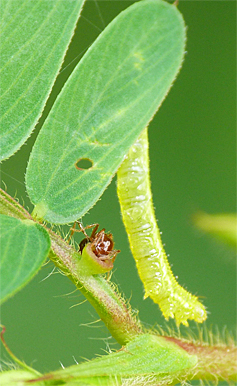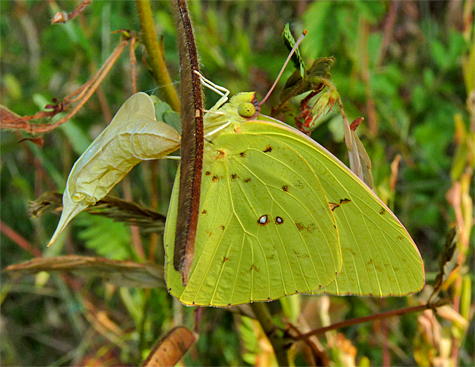
A recent post to this Journal featured two caterpillars, one of those was the larva of a Cloudless Sulphur butterfly on Partridge Pea in Catch the Wind. On August 2, I noticed one of these large yellow sulphurs lay at least one egg on the plant. Fives days later I saw one, then two, caterpillars munching away on the plant’s flowers.
It’s now August 15, and the caterpillars have grown considerably. They will probably crawl off to pupate within a day or two, if they haven’t already.
There are precious few Partridge Pea plants in Catch the Wind. I try to maintain the plants specifically for these butterflies because it’s a great way to show campers and Museum visitors the life cycle of butterflies close up, with wild butterflies.
The little patch of this low growing legume is right next to the path and anyone who passes it can witness the spectacle, if they choose to stop and have a look.
Most butterflies have preferences for certain plants as hosts for their larvae. Cloudless Sulphurs have a definite taste for Partridge Pea.

The caterpillar in the top photo is about the length of one of the leaflets of the plant. It has now grown to nearly the length of the entire leaf (photo immediately above).
When this caterpillar finally does pupate and forms its chrysalis it will take a week or so for it to emerge as an adult Cloudless Sulphur.

The pupa, or chrysalis, can be very difficult to locate so keep a sharp eye out when you walk past this little patch of Partridge Pea. It’s directly across from the map of Catch the Wind on the back side of the Explore the Wild/Catch the Wind loop.
Your pictures of the Sulphur and caterpillar are great Greg as I know this butterfly is a difficult one to capture. I have a question regarding the Pipevine Swallowtail. I have the butterflies in my yard and spotted a caterpillar a few days ago. I am puzzled as to what the caterpillar fed on. So far as I know there are no pipevines plants near my home. In my research, I cannot find information if they have other food sources. I am very stumped on this, hope you can help.
Thanks regarding the sulphurs. There are only a handful of Partridge Pea plants here at the museum so it’s almost like having a captive group of butterflies/larva, they can only lay eggs in a small area. And, I was very lucky in happening to be there when the caterpillar began forming its chrysalis. I watched the chrysalis each day. When it began to darken I knew that the following morning there would be a butterfly there instead of a pupa.
As far as the Pipevine Swallowtail, I’d be willing to bet that there’s some pipevine growing nearby. Some of the plants in the genus are rather inconspicuous. The low growing Virginia Snakeroot (Aristolochia serpentaria) which is what grows naturally here in the Piedmont can be easily overlooked.
Thanks, and good luck.